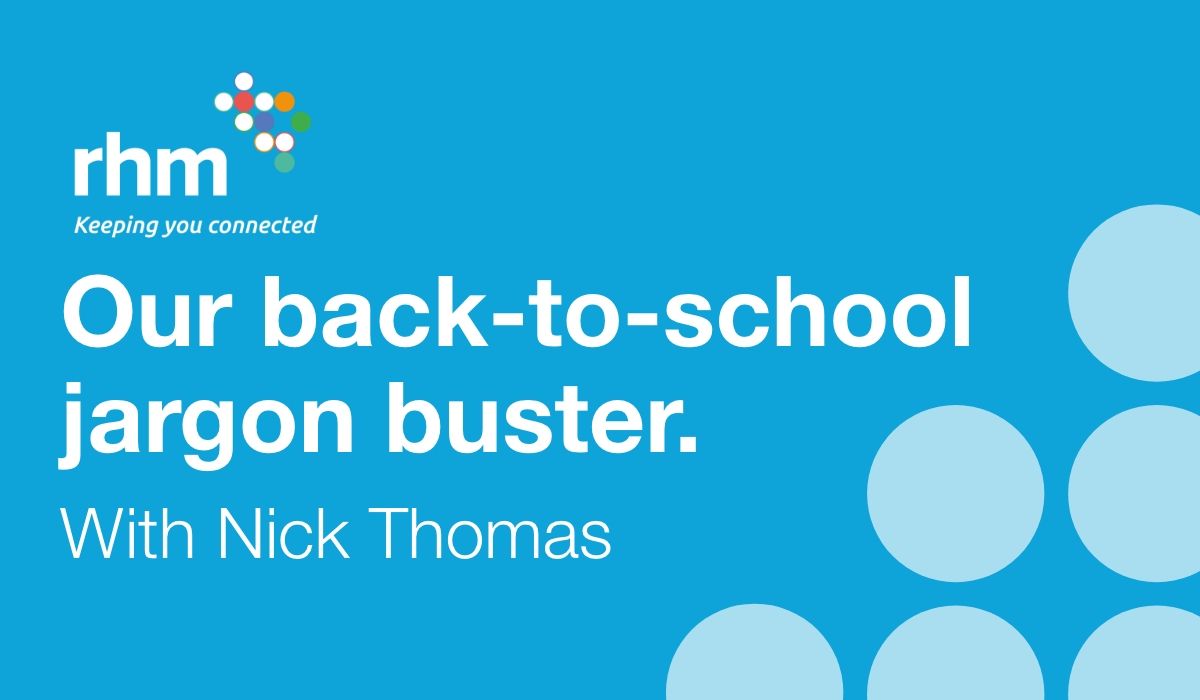
I’ve been in the telecoms industry for a long time. There’s been a lot of change in the industry, but our love of jargon has always stayed the same. No matter how hard we try, there’s nothing that can’t be condensed into a TLA (three-letter acronym) apparently!
This makes communications technology pretty impenetrable for a lot of people. That’s not ideal, as great communications are one of the foundations of successful businesses. At RHM we’ve always had the goal of simplifying technology, so I think it’s great to show that this tech isn’t as complicated as it sounds. With that in mind, here’s our attempt to create a fairly comprehensive telephony jargon buster.
ADSL (Asymmetric Digital Subscriber Line) is a service that transmits data on copper telephone lines to your home or business. ADSL was the successor to dial-up, and its main benefit was that it was always available when you need it. Fibre broadband has now replaced most ADSL connections.
An auto-attendant is essentially a virtual receptionist for your business. It is a menu that callers are greeted by when they dial in to your business that ensures they get directed to the right department. Auto-attendants are very popular in call centres.
Call forwarding or call diversion is a feature which redirects incoming calls to a different number than the one originally called. This is very useful if staff are away from their office system and are working on their mobile for example.
A call queue is essentially a virtual waiting room. It helps to manage calls when your team are busy with other callers. When callers are waiting in the queue they are on hold. When they reach the front of the queue, their call will be distributed to the selected member of your team.
Cloud communication, or a cloud phone system, is a service where your phone system is hosted in the cloud, in secure data centres, instead of as physical hardware on your site. This means the whole system is accessible via the internet, from anywhere with a connection.
DDI (Direct Dialling In) is a system that allows callers to bypass your auto-attendant and call a chosen extension. This means if they know exactly who they want to speak to, callers can get in touch much faster.
DECT (digital enhanced cordless telecommunications) are wireless phones that connect to your business’s Wi-Fi. They are perfect for teams working on warehouses and shop floors, or anyone who needs to walk and talk!
FTTC (fibre to the cabinet) is the most common form of fibre broadband. This service runs superfast fibre cables to your local cabinet (those green ones that you see on the pavement). FTTC then runs copper cables the rest of the way to your premises.
FTTP (fibre to the premises) take FTTC a step further. FTTP only uses fibre connections directly to your business. This allows for faster speeds and means you don’t compete for signal with surrounding businesses.
A hunt group is a phone system feature that distributes calls to a group of numbers rather than just one. This naturally means there’s a greater chance of someone answering the call quickly. It’s great for support teams or call centres.
ISDN (integrated services digital network) is a phone network used to make phone calls and transmit data over PSTN circuits. ISDN2e lines are often used for smaller businesses whereas larger teams use ISDN30. ISDN lines will be fully switched off in 2025.
IVR (interactive voice response) is a phone system feature that allows callers to interact with the system using options on a menu. Callers can enter responses by dialling the numbers on their keypad or with their voice.
A leased line is a private connection between two or more locations, also known as a data line. These lines can be used to reconnect separate offices and offer blazing fast connections, although usually at a higher price point.
Number porting is the process of moving your phone number(s) over to a new provider, without losing access to your phone number. This process should be straightforward and can normally be handled by your new provider.
A PBX (private branch exchange) system is a phone system hosted within your business. It’s also known as an on-premise phone system. PBX systems can either use older ISDN or PSTN lines to host calls, but most modern systems now use internet-based VoIP instead.
The PSTN (public switched telephone network) is the combination of telephone networks used across the country. PSTN essentially takes your call from your phone to the recipient’s phone. Like ISDN, which came after it, PSTN is switching off in 2025 to make way for internet-based services.
SIP (session initiation protocol) trunking is a way of routing calls over the internet. It’s an alternative to the PSTN and ISDN services mentioned previously.
Unified communications is an application that combines every mode of business communication in a single service. This includes voice and video calls, instant messaging and may include email integration. Examples of UC services include Microsoft Teams.
VoIP (voice over internet protocol) delivers calls via the internet rather than copper lines. VoIP has been around for many years, you may have used it for Skype in the 2000s. It has since become the primary method of communication for most businesses, and alongside SIP will fully replace older ISDN and PSTN systems in 2025.
© rhm telecommunications 2024